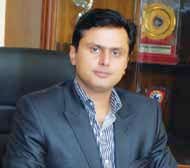

An innovative mind is every country’s asset and to build this asset STEM helps in a big way
By Sharmila Das, Elets News Network (ENN)
STEM or Science, Technology, Engineering and Mathematics education provides that environment to think beyond ordinary. To use scientific investigation, knowledge and practices in understanding the whole world. The progressive educationists of the world have come to the conclusion that STEM education should be encouraged in the early education of a child. Only through STEM we can have the wherewithal to develop an innovative mind. This approach to education is designed to revolutionise the teaching of subject areas such as mathematics and science by incorporating technology and engineering into regular curriculum by creating a meta-discipline. STEM Education attempts to transform the typical teacher-centred classroom by encouraging a curriculum that is driven by problem-solving, discovery, exploratory learning, and requires students to actively engage in a particular type of a situation in order to reach a logical solution.
Does it fill the bill?
Letting students explore ideas in science and watching them learn is truly a passion that most teachers share. It is inspiring to watch a student work through a science investigation and get to the “aha” moment of understanding, seeing their eyes light up, the smile broaden across their face, and the explosion of energy as they rush to explain to someone what they have just discovered.
As a nation we should capitalise on the “aha” moments and work hard to help students not only understand science, but also foster a lifelong learning in science. Why is this so important?
?Science is the one subject that encompasses everything in life and helps students be curious, ask questions, and make connections as to why the world exists as it does. It is the backdrop for understanding our world, and helps us to explain and appreciate it in new ways.
?A successful STEM education provides students with science, math, and engineering/technology in sequences that build upon each other and can be used with real-world applications.
STEM education creates critical thinkers, increases science literacy, and enables the next generation of innovators. Innovation leads to new products and processes that sustain our economy. This innovation and science literacy depends on a solid knowledge base in the STEM areas. It is imperative that as a nation, we make STEM education a top priority.
Roadblocks
As with any educational initiative, there will be noted barriers to the successful implementation of STEM education into education systems. Developing a curriculum to include STEM as fully integrated requires funding that may presently be unavailable. In order to provide all students with STEM education, funding would be needed not only to develop the curriculum to support STEM, but also to expose students to STEM careers, provide on-going and sustainable STEM professional development, provide STEM preservice teacher training, provide mathand science-related competitions, include mentoring and internship programs, provide hands-on science activities, and recruit and retain STEM teachers.
Another area noted as a barrier to the successful implementation of STEM into a school’s curriculum is the lack of necessary leadership to infuse STEM approaches into a current educational system. Studies of various school curriculums suggest that while curriculum appears to include science and math, all too often, engineering is missing from the curriculum. There may also be school policies around credits and curriculum that may hinder successful implementation of STEM. School systems may feel that the school’s curriculum is already too crowded with classes/studies.
Another factor that hinders the high-quality STEM education in K-12 is the lack of qualified teachers. The most successful implementation of STEM education would require professionals to instruct classes in science, technology, engineering, and mathematics or at least provide good role models for students to inspire them to pursue careers in STEM.
Beyond educational obstacles, there may be barriers that include cultural perceptions on the part of parents and students that may hinder students from becoming involved in science and mathematics. According to Mary Ann Wolf, Executive Director, SETDA, societal attitudes and perceptions do need to change regarding careers in engineering, science, and mathematics. She emphasises the need to change the mind-set of people and the stigma attached (often called “geek”) to those excelling in the areas of science, mathematics, and engineering. Research suggests that a strong emphasis must be placed on STEM education to inspire our students to seek careers inSTEM so that we may continue to compete globally for jobs and prepare our students for the 21st Century.
To create such ambiance the role of private players offering STEM solution is crucial. To understand their role, we got in touch with Jaganathan. C, Director, Education Technology of Texas Instruments, India. He says, “Texas Instrument (TI) is working with the government and private education entities to inculcate one-to-one learning practices using TI Nspired Learning solutions for classroom teaching and learning, real time experience of concepts in the lab and beyond, and classroom assessment. Our solutions are implemented in the market for CBSE schools through partners like CORE Education and Technologies who specialise in education services. We have run pilot programs in 2010-11 on TI Nspired Learning in nine schools in Delhi, Bangalore and Chennai including two Kendriya Vidyalaya Sanghatan schools and our solution is being considered by schools”.
STEM in early education
State Educational Technology Directors Association (SETDA) 2008 says states and school districts should begin the development of a plan in kindergarten to implement STEM education and develop specific targets to achieve these goals. Based on past indicators, little emphasis is placed on science as a major subject area, often being taught once or twice a
week at the elementary level.
Experts Speak
 Ashish Kesharwani, Chief Learning Officer, UEI-Global believes, “Future holds great hope and scope for Maths, Science and Engineering background students. Thus the need to create interest amongst the student fraternity to take up this stream is required. It is evident right from school education that these are dreaded subjects and teachers use traditional/ conventional methods to teach them. Being innovative and practical orientation / application will help generate interest in this field. This will increase the creativity and analytical ability, thereby enabling students to use their knowledge in real world environment. There is dearth of technical graduates. Also the graduates that pass-out lack application skills since the current education system lacks practical learning. Thus the IT and Engineering companies need to spend more time and money on training fresh graduates. At the moment it does not cost much since the wages are low and manpower is available in abundance, this will not be the case in future thus, not only from education but from industry and economy point of view STEM education will help in creating interest and upgrading skills”.
Ashish Kesharwani, Chief Learning Officer, UEI-Global believes, “Future holds great hope and scope for Maths, Science and Engineering background students. Thus the need to create interest amongst the student fraternity to take up this stream is required. It is evident right from school education that these are dreaded subjects and teachers use traditional/ conventional methods to teach them. Being innovative and practical orientation / application will help generate interest in this field. This will increase the creativity and analytical ability, thereby enabling students to use their knowledge in real world environment. There is dearth of technical graduates. Also the graduates that pass-out lack application skills since the current education system lacks practical learning. Thus the IT and Engineering companies need to spend more time and money on training fresh graduates. At the moment it does not cost much since the wages are low and manpower is available in abundance, this will not be the case in future thus, not only from education but from industry and economy point of view STEM education will help in creating interest and upgrading skills”.
Future holds great hope and scope for Maths, Science & Engineering background students. Thus the need to create interest amongst the student fraternity to take up this stream is required
Kartikay Saini, Chairman, The Scottish High International School says, “There are definitely few aspects of STEM which are currently been followed by the Indian education sector in different forms. With the ever changing innovation in education, the Indian education sector may be interested to research and implement the same in the near future”.
Stem education will empower students and teachers enabling them to address some of the bigger social challenges around the world and in their communities
Prof Shanath Kumar, Head, ELearning, SMU-DE of Sikkim Manipal University says, “STEM Education is the foundation for development and progress for any country, more so for a developing country such as India. Proof has come in the form of thousands of Indian youth migrating and serving abroad in information technology and several other engineering and science fields. The country has also grown rich in terms of high quality educational institutions of STEM imparting professional education to millions of students every year. Technology offers an excellent opportunity to scale up this education system and to carry the efforts into the remotest corners of the country. This will provide the much needed Human Development effort for India. India has also produced hundreds of entrepreneurs from the STEM education. Increased thrust on entrepreneurship will provide the impetus for innovation and thus propel the country towards high growth rates and into the league of developed countries of the world. The sign of this happening is already visible.
However, excellent technology infrastructure, consistent faculty development efforts and adequate number of faculty, newer pedagogical methods to enhance employability and increasing industry connect will be the challenges which we should overcome and change into opportunities”.
 Jaganathan C of Texas Instruments says, “In India, we have been witnessing a significant improvement in the infrastructure in primary, upper primary and secondary schools in the last 10 years and more so with respect to public schools. Though there are some important issues that call for attention both in the infrastructure and professional teaching areas, enrolments in school are on a gradual rise”.
Jaganathan C of Texas Instruments says, “In India, we have been witnessing a significant improvement in the infrastructure in primary, upper primary and secondary schools in the last 10 years and more so with respect to public schools. Though there are some important issues that call for attention both in the infrastructure and professional teaching areas, enrolments in school are on a gradual rise”.
Texas Instrument (TI) is working with the government and private education entities to inculcate one-to-one learning practices using TI Nspired Learning solutions for classroom teaching and learning
 Vandana Lulla, Principal of Podar International School (IB and CIE) says, “Stem education will empower students and teachers enabling them to address some of the bigger social challenges around the world and in their communities. It will help institutions and students to think out-of-the-box for solutions and ideas that are both collaborative and creative”.
Vandana Lulla, Principal of Podar International School (IB and CIE) says, “Stem education will empower students and teachers enabling them to address some of the bigger social challenges around the world and in their communities. It will help institutions and students to think out-of-the-box for solutions and ideas that are both collaborative and creative”.
Stem education will empower students and teachers enabling them to address some of the bigger social challenges around the world and in their communities
 Amit Rana, Pro-Vice Chairman of DPS-Panipat comments, “The STEM system is a good start. Proper training and continued usage will lead to competence and then to innovative techniques using STEM technology in education. Our education system needs a thorough revamping and technology cannot be ignored”.
Amit Rana, Pro-Vice Chairman of DPS-Panipat comments, “The STEM system is a good start. Proper training and continued usage will lead to competence and then to innovative techniques using STEM technology in education. Our education system needs a thorough revamping and technology cannot be ignored”.
The STEM system is a good start. Proper training and continued usage will lead to competence and then to innovative techniques using STEM technology in education
End Note
Last but not the least, inclination towards a more scientific approach of education is required from the education eco-system and it is not restricted to schools and higher education institutes alone.






















